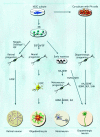Human embryonic stem cell differentiation toward regional specific neural precursors
- PMID: 18845761
- PMCID: PMC2729673
- DOI: 10.1634/stemcells.2008-0543
Human embryonic stem cell differentiation toward regional specific neural precursors
Abstract
Human embryonic stem cells (hESCs) are self-renewing pluripotent cells that have the capacity to differentiate into a wide variety of cell types. This potentiality represents a promising source to overcome many human diseases by providing an unlimited supply of all cell types, including cells with neural characteristics. Therefore, this review summarizes early neural development and the potential of hESCs to differentiate under in vitro conditions, examining at the same time the potential use of differentiated hESCs for therapeutic applications for neural tissue and cell regeneration.
Figures




References
-
- Thomson JA, Itskovitz-Eldor J, Shapiro SS, et al. Embryonic stem cell lines derived from human blastocysts. Science. 1998;282:1145–1147. - PubMed
-
- Buzzard JJ, Gough NM, Crook JM, et al. Karyotype of human ES cells during extended culture. Nat Biotechnol. 2004;22:381–382. - PubMed
-
- Heins N, Englund MC, Sjöblom C, et al. Derivation, characterization, and differentiation of human embryonic stem cells. Stem Cells. 2004;22:367–376. - PubMed
-
- Reubinoff BE, Pera MF, Fong CY, et al. Embryonic stem cell lines from human blastocysts: Somatic differentiation in vitro. Nat Biotechnol. 2000;18:399–404. - PubMed
-
- Carpenter MK, Inokuma MS, Denham J, et al. Enrichment of neurons and neural precursors from human embryonic stem cells. Exp Neurol. 2001;172:383–397. - PubMed
Publication types
MeSH terms
LinkOut - more resources
Full Text Sources
Other Literature Sources

